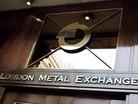London Metal Exchange: Trading Hub With 450-Year History

This week the London Metal Exchange (LME) is holding the LME Week conference -- one of the world's largest annual gatherings of mining executives. To mark the event, we take a look at the amazing 450-year history of the LME.
How did the LME begin life?
The London Metal Exchange (LME) is a key price setter for global metal markets, and traces its origins to 1571 when traders began meeting at the Royal Exchange in London. As Britain's metal export sector expanded, European merchants joined these gatherings, establishing the foundations for today's global metals trading hub.
In the early 18th century, metal merchants moved their trading to the Jerusalem Coffee House due to overcrowding at the Royal Exchange. Along with other coffee houses like the more famous Lloyds, it was where shipping news would first be broken. A trader seeking to conduct business would draw a circle in sawdust on the floor and call out "change", establishing the ‘ring trading’ tradition that continues today.
The practice of ‘kerb trading’ emerged when coffee houses closed, forcing traders onto street kerbs to continue transactions, highlighting the need for extended trading hours. Today, the modern LME runs 24/7 through its phone-based trading system.
In 1877, the London Metal Market and Exchange Company established its first official premises above a hat shop in Lombard Court. The exchange facilitated trading in tin, copper and pig iron, responding to industrial Britain's growing demand for metals.
First World War impact, and other crises
The outbreak of World War I in July 1914 caused the LME to temporarily suspend operations due to concerns over potential supply shortages. Trading resumed in autumn of the same year, highlighting the exchange's resilience during global disruption.
Throughout its history, the LME has encountered several market crises. In 1985, the exchange suspended tin trading after the International Tin Council's price support mechanism collapsed. In 1996, Sumitomo Corporation Head Trader Yasuo Hamanaka created market turbulence after losing $2.6 billion in copper trading over ten years.
The COVID-19 pandemic led to the temporary closure of the Ring in March 2020. Despite a proposal in January 2021 to permanently move to electronic trading, the Ring reopened in September 2021 following resistance from exchange members.
The Hong Kong Exchanges and Clearing deal
Hong Kong Exchanges and Clearing acquired the LME in 2012 for £1.4 billion, positioning the exchange to serve the shift of manufacturing to Asia. The acquisition maintained the LME's role as a global price setter for industrial metals while expanding its reach into Asian markets.
The LME operates three trading methods: open outcry in the Ring, electronic trading via LME Select, and a 24-hour telephone market. In 2001, the exchange launched LME Select, an electronic trading platform developed by Swedish software company Cinnober, using Financial Information Exchange (FIX) protocol.
How the LME works
The exchange offers standardised contracts with various expiration dates, allowing traders to select daily, weekly or monthly options. Contract sizes, measured in lots, range from 1 to 65 metric tonnes, varying by metal type.
Despite the trend towards electronic trading, the LME remains Europe's only physical commodities trading market. Ring trading occurs in five-minute intervals within a six-metre diameter circle, with display boards showing current prices. Members occupy fixed seats, assisted by staff who relay orders and market information.
LME Clear provides financial security for metal trades
In July 2010, the LME opened its first office outside London in Singapore, reflecting the growing importance of Asian metal markets. The expansion aligns with the exchange's strategy to serve the global metals trading community.
In 2014, the LME established LME Clear, its clearing house designed to provide European Market Infrastructure Regulation (EMIR) compliant clearing and settlement services.
In 2019, and for the first time in its history, the LME appointed a female chair of the board. Gay Huey Evans, OBE, has more than 30 years’ experience in the financial sector, having worked for a host of bodies including the London Stock Exchange Group and Aviva.




